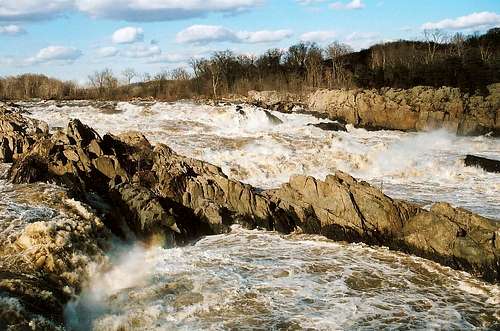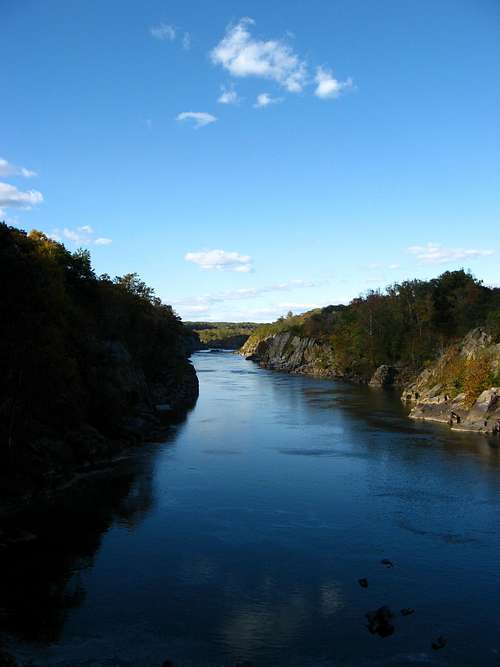-
 43329 Hits
43329 Hits
-
 96.25% Score
96.25% Score
-
 58 Votes
58 Votes
|
|
Area/Range |
|---|---|
|
|
39.00210°N / 77.2541°W |
|
|
Hiking, Trad Climbing, Toprope, Bouldering, Aid Climbing, Scrambling |
|
|
Spring, Summer, Fall, Winter |
|
|
Overview
Unofficially, the Great Falls area is the top climbing spot in the Washington, D.C. region.
Many people crossing one of Washington, D.C.’s Potomac River bridges and looking at the wide, placid waters would be surprised to know that less than a 30-minute drive upstream (if traffic didn’t exist), the river roars through a rocky gorge with deadly, rock-gouging force. At Great Falls, close to the C.I.A. headquarters (SP members who thumb their noses at No Trespassing signs ought not to push their luck here!), the river cuts several channels through jagged rocks and then winds through rocky Mather Gorge before turning into the tame-looking waterway that crawls through the nation’s capital.
Residents of the East get few real opportunities for anything resembling true alpine climbing close to home, but rock climbers can find happiness aplenty at Great Falls Park in Virginia, which is administered by the National Park Service and is unofficially regarded as the top climbing area in the D.C. region, though it has rivals at nearby Carderock and Annapolis Rock, both in Maryland. Routes on cliffs and outcrops range from Class 3 to 5.13, and the area has something for everyone. Out here, new climbers learn techniques, experienced climbers practice their skills as they train for other climbs, and true human spiders redefine their art.
On the Maryland side of the river, the good climbing cliffs are not as numerous, but there are still several excellent crags. That land is part of the C&O Canal National Historical Park, also administered by the National Park Service. Though not a part of Great Falls Park, the Maryland side is certainly part of the Great Falls area, and Carderock, technically not part of Mather Gorge, the area's showpiece and home to most of the climbing crags, is part of the C&O Canal National Historical Park and is probably the most popular climbing spot in the region.
Although the routes here are short (up to about 70'), this is NOT an area for sport climbing. Almost all old bolts have been removed, and park rules and local ethics preclude new drilling and bolting. Toproping is the norm here, but some routes are suitable for leading. YOU decide when you examine the routes yourself. Do note that trad climbing is not popular here because although the rock is nice and solid, protection is known to break the rock or slip out. If you lead at all, you should lead on passive gear except on deep, solid cracks. Do not trust cams in flakes and shallow cracks here!
Great Falls Park offers much more than climbing; hiking, mountain biking, kayaking, wildlife viewing, and just plain old family picnicking are also popular. This page, and its children, though, will focus on the climbing, aside from the scenic (I hope) pictures of the area itself.
An excellent resource for the area is Eric Horst’s Rock Climbing Virginia, West Virginia, and Maryland. The section on Great Falls provides one-sentence overviews of the routes. Also, consider the PATC Climbers' Guide. It focuses just on the Great Falls area and details more crags and routes than the other guide does. Another great guidebook is Carderock Past and Present, published by PATC (Potomac Appalachian Trail Club). The PATC guide fits nicely into a pack pocket and is full of excellent photographs that help locate the routes.
The Crags
Upstream-downstream, the crags are as follows:
* In my opinion, this is one of the best climbing crags in the area due to its collection of quality routes. This does not mean that other crags do not have high-quality routes; in fact, some of the best climbs in the area are at some of those other crags. However, the noted crags have several quality routes that can keep a party happy all day.
Thumbs of Select Crags-- Virginia Side
Part 1
 Riverbend Wall Riverbend Wall |
 Gorky Park Gorky Park |
 Microdome Microdome |
 Fish Face Fish Face |
 Flat Iron Flat Iron |
 Sandbox Sandbox |
 Cigar Box Cigar Box |
 Dihedrals Dihedrals |
 Dike Creek Dike Creek |
 Juliet's Balcony Juliet's Balcony |
 Seclusion Seclusion |
Part 2
 Romeo's Ladder Romeo's Ladder |
 Little Aid Box Little Aid Box |
 Aid Box Aid Box |
 Canal Cut Canal Cut |
 Cornice Cornice |
 Bird's Nest Bird's Nest |
 Dr. Needlepoint Dr. Needlepoint |
 Degree 101 Degree 101 |
 Downstream Climbs Downstream Climbs |
 Cow Hoof Cow Hoof |
 Echo Rock Echo Rock |
Thumbs of Select Crags-- Maryland Side
 Bulges Bulges |
 Rocky Islands Rocky Islands |
 Greek Wall Greek Wall |
 Atrium Atrium |
 Trojan Wall Trojan Wall |
 Spitzbergen Spitzbergen |
 Purple Horse Purple Horse |
 Crag X Crag X |
 Cupid's Bower Cupid's Bower |
 Carderock Carderock |
Getting There
Locals will know their own best ways. For others, though, these directions are easiest to follow:For Great Falls Park—From the western part of I-495, a piece of the Capital Beltway, take Exit 44 for Route 193, Georgetown Pike; this is the second exit south of the Maryland border. Drive west for a few miles until you see the well-signed road leading to Great Falls Park. Turn right and follow the road about a mile to the entrance station. There are two large parking lots after the entrance station.
For C&O Canal NHP—From I-495, take Exit 41, just north of the Virginia line, heading west on the Clara Barton Parkway and then onto MacArthur Boulevard. MacArthur leads directly to the park entrance, but some people park at Old Angler’s Inn along the way and access the Billy Goat Trail (for free, and it leads to several climbing crags) from there.
Red Tape
The parks are open from 7 A.M. until dark. There is an admission fee, good for three days, of $10 per vehicle. The fee is good for entry to both parks. Annual passes and the America the Beautiful Pass ($80 for the latter) are also available.Climbers in Great Falls Park are aasked to register (free). There is a registration box at the climbers’ parking area, and there is also one at the visitor center.
Drilling to place bolts is prohibited. If you use chalk, try to use colors that blend with the rock here.
The area is popular and can be quite crowded, especially on weekends spring through fall. Also, some of the people there, skilled as they may be, are less the sanctity-of-nature types and more the types who see mountains and crags as a climbing gym with cool views. Don’t be surprised to see a climber smoking a cigarette as he waits his turn. So if you prefer a little communion with your climbing, try going on a weekday or in winter (but be aware that mornings, when the Virginia side of the Great Falls area gets plenty of sun, are often in the 20’s F or lower in winter, not great for climbing).
The parks are home to copperheads. It’s unlikely that they hang out in holds on 5.10 cliffs, but be aware. The danger, though slim, is greatest near the clifftops, especially those near trees, where there are more places for snakes to be.
Camping
There is no camping in either park. The areas adjacent to the parks are private property. Great Falls is a day-use area.External Links
Great Falls NPS siteC&O Canal NPS site





